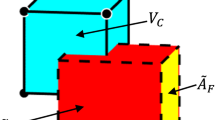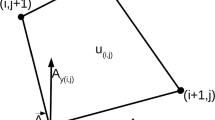Abstract
Forward modeling is the basis of inversion imaging and quantitative interpretation for DC resistivity exploration. Currently, a numerical model of the DC resistivity method must be finely divided to obtain a highly accurate solution under complex conditions, resulting in a long calculation time and large storage. Therefore, we propose a 3D numerical simulation method in a mixed space-wavenumber domain to overcome this challenge. The partial differential equation about abnormal potential is transformed into many independent ordinary differential equations with different wavenumbers using a 2D Fourier transform along the x axis and y axis direction. In this way, a large-scale 3D numerical simulation problem is decomposed into several 1D numerical simulation problems, which significantly reduces the computational and storage requirements. In addition, these ordinary 1D differential equations with different wavenumbers are independent of each other and high parallelelism of the algorithm. They are solved using a finite-element algorithm combined with a chasing method, and the obtained solution is modified using a contraction operator. In this method, the vertical direction is reserved as the spatial domain, then grid size can be determined flexibly based on the underground current density distribution, which considers the solution accuracy and calculation efficiency. In addition, for the first time, we use the contraction operator in the integral equation method to iterate the algorithm. The algorithm takes advantage of the high efficiency of the standard Fourier transform and chasing method, as well as the fast convergence of the contraction operator. We verified the accuracy of the algorithm and the convergence of the contraction operator. Compared with a volume integral method and goal-oriented adaptive finite-element method, the proposed algorithm has lower memory requirements and high computational efficiency, making it suitable for calculating a model with large-scale nodes. Moreover, different examples are used to verify the high adaptability and parallelism of the proposed algorithm. The findings show that the 3D numerical simulation method of DC resistivity method in a mixed space-wavenumber domain is highly efficient, precise, and parallel.
Similar content being viewed by others
References
Berdichevsky, M. N., and Zhdanov, M. S., 1984, Advanced theory of deep geomagnetic sounding: Science Publishers, 41(1), 0–72.
Boisvert R. F., 1991, Algorithms for special tridiagonal systems: Society for Industrial and Applied Mathematics, 12, 423–442.
Born, M., 1933, Optik: Springer, Berlin, 591.
Chai Y. P., 1997, Shift sampling theory and its application (in Chinese), Beijing, China Petroleum Industry Press.
Dai, S. K., Zhao, D. D., and Zhang, Q. J., et al., 2018, Three-dimensional numerical modeling of gravity anomalies based on Poisson equation in space-wavenumber mixed domain: Applied Geophysics, 15(3–4), 513–523.
Dai, S. K., Zhao, D. D., and Wang, S. G., et al., 2019, Three-dimensional numerical modeling of gravity and magnetic anomaly in a mixed space-wavenumber domain: Geophysics, 84(4), G41–G54.
Gao, G., and Torres-Verdin, C., 2006a, High-order generalized extended born approximations to electromagnetic scattering: IEEE Transactions on Antennas and Propagation, 54(4), 1243–1256.
Gao, G., and Torres-Verdin, C., 2006b, Efficient Numerical Simulation of Axisymmetric Electromagnetic Induction Data using a High-Order Generalized Extended Born Approximation: IEEE Transactions on Geoscience & Remote Sensing.
Gao, W. F., Zhai, P. H., Xiao, L. L., et al., 2018, Research and application of the 3D DC resistivity method with around working face: Chinese Journal of Geophysics (in Chinese), 63(9), 3534–3544.
Greenhalgh, M. S., 2009, DC resistivity modelling and sensitivity analysis in anisotropic media: Ph. D. theses, Adelaide: The University of Adelaide.
Li, P., and Frank, S., 2004, Direct current electric potential in an anisotropic half-space with vertical contact containing a conductive 3D body: Mathematical Problems in Engineering, 1(1), 63–77.
Li, Y. G, and Spitzer, K., 2005, Finite element resistivity modelling for three-dimensional structures with arbitrary anisotropy: Physics of the Earth & Planetary Interiors, 150(1), 15–27.
Lu, J. J., Wu, X. P., and Spitzer, K., 2009 Algebraic multigrid method for 3D DC resistivity modeling, Chinese Journal of Geophysics (in Chinese), 53(3), 700–707.
Méndez-Delgado, S., Gómez-Treviňo, E., and Pérez-Flores, M. A., 1999, Forward modelling of direct current and low-frequency electromagnetic fields using integral equations: Geophysical Journal International, 137(2), 336–352.
Penz, S., Chauris, H., Donno, D., et al., 2013, Resistivity modeling with topography: Geophysical Journal International, 194(3), 1486–1497.
Plattner, A., Maurer, H., Vorloeper, J., et al., 2010, Three-dimensional geoelectric modeling with optimal work/accuracy rate using an adaptive wavelet algorithm: Geophysical Journal International, 182(2), 741–752.
Plattner, A., Maurer, H., Vorloeper, J., et al., 2012, 3D electrical resistivity tomography using adaptivewavelet parameter grids: Geophysical Journal International, 189(1), 317–330.
Ren, Z. Y., and Tang, J. T., 2014, A goal-oriented adaptive finite-element approach for multi-electrode resistivity system: Geophysical Journal International, 199(1), 136–145.
Ren, Z. Y., Chen, H., and Tang, J. T., 2018a, A volume-surface integral approach for direct current resistivity problems with topography: Geophysics, 83(5), E293–E302.
Ren, Z. Y., Chen, H., and Tang, J. T., 2018b, Accurate volume integral solutions of direct current resistivity potentials for inhomogeneous conductivities in half space: Journal of Applied Geophysics, 151, 40–46.
Rücker, C., Giinther, T., and Spitzer, K., 2006, Three-dimensional modeling and inversion of DC resistivity data incorporating topography: II: Inversion: Geophysical Journal International, 166(2), 495–505.
Song T., Liu Y., and Wang Y., 2021, Numerical modeling of anisotropy paradoxes in direct current resistivity and time-domain induced polarization methods: Applied Geophysics, 18(1), 117–127.
The OpenMP ARB, 2021, The OpenMP API specification for parallel programming, https://www.openmp.org/.
Tontini, F. C., Cocchi, L., and Carmisciano, C. 2009, Rapid 3-D forward model of potential fields with application to the Palinuro Seamount magnetic anomaly (southern Tyrrhenian Sea, Italy): Journal of Geophysical Research Solid Earth, 114(B2), 1205–1222.
Wu, L., and Tian, G., 2014, High-precision Fourier forward modeling of potential field: Geophysics, 79(5), G59–G68.
Xu, S. Z., 1994, The finite element method in Geophysics (in Chinese), Beijing, Science Press.
Zhdanov, M. S., and Fang, S., 1997, Quasi-linear series in 3D electromagnetic modeling: Radio Science, 32(6), 2167–2188.
Zhou, B., and Greenhalgh, S. A., 2001, Finite element three-dimensional direct current resistivity modeling: accuracy and efficiency considerations: Geophysical Journal International, 145, 679–688.
Acknowledgments
The authors would like to thanks the members of the research group in room 504, Mittal tower, Central South University, for their help in the preparation of this study. The author also would like to thanks Dr. Chen Huang of Central South University for his help in the process of numerical simulation, as well as anonymous experts and experts from the editorial department for their valuable comments.
Author information
Authors and Affiliations
Corresponding author
Additional information
This work was supported by subproject of National Key Research and Development plan (No. 2018YF C060360201) National Natural Science Foundation of China (42174080), innovation research team project of Guangxi Natural Science Foundation (GXNSFGA380004) and Independent Exploration and Innovation Project for Postgraduates of Central South University (2018zzts200, 2018zzts203).
Dai shi-kun received his Ph.D. degree from the Ocean University of China in 1994. Now, he is a professor at Central South University. He is mainly engaged in the research on the theory, method, and technology of 3D efficient and high-precision numerical simulations and inversion imaging of gravity, magnetism, electricity, and seismic exploration. He is committed to the research, development, and improvement of geological, geophysical exploration information systems. He is establishing and improving the holographic electromagnetic exploration theory and method technology system and developing holographic electromagnetic exploration instruments and equipment, data processing, inversion imaging, and analysis and interpretation software system, as well as carrying out testing and exploration application research.
Ling Jia-xuan received his M.S. degree from the Guilin University of Technology in 2017 and is now studying for a doctorate at Central South University. He is mainly engaged in the research of 3D efficient forward and inverse theory of electromagnetic method.
Rights and permissions
About this article
Cite this article
Dai, SK., Ling, JX., Chen, QR. et al. Numerical modeling of 3D DC resistivity method in the mixed space-wavenumber domain. Appl. Geophys. 18, 361–374 (2021). https://doi.org/10.1007/s11770-021-0904-4
Received:
Revised:
Published:
Issue Date:
DOI: https://doi.org/10.1007/s11770-021-0904-4




